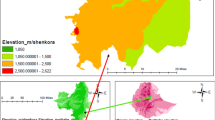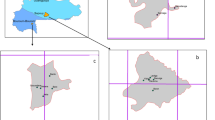Abstract
Carbon sequestration in agroforestry systems plays an important role for climate change regulation. Policy makers make use of growth models for carbon estimations of the large scale projects in designing regulation. This study revealed the aboveground carbon sequestration potentials and established allometric growth models of four species in agroforestry. Based on the results, the aboveground carbon storages of Morinda tinctoria Roxb., Terminalia oliveri Brandis., Rhus paniculata Wall. and Emblica officinalis Gaertn. were 6.88, 6.59, 4.34 and 3.53 kg C tree−1, respectively. In comparison between two types of agroforestry, a mixture of M. tinctoria and E. officinalis had a higher carbon sequestration potential (1331 kg C ha−1) than a mixture of R. paniculata and T. oliveri (1151.40 kg C ha−1). A hyperbolic growth model and a basic quadratic model were the best-fit models for R. paniculata and E. officinalis, respectively, while a basic logarithmic model was the best fit for both M. tinctoria and T. oliveri. This study highlighted that both Akaike Information Criterion, Furnival index and coefficient of determination should be taken into consideration for model selection, as opposed to only considering the coefficient of determination. The study also pointed out that a mixture of M. tinctoria and T. oliveri should be considered as a tentative model for agroforestry plantations to enhance the carbon storage in semi-arid area in the future.


Similar content being viewed by others
References
Akaike H (1974) A new look at the statistical model identification. IEEE Trans Autom Control 19:716–723
Albrecht A, Kandji ST (2003) Carbon sequestration in tropical agroforestry systems. Agric Ecosyst Envion 99:15–27
Anscombe FJ (1973) Graphs in statistical analysis. Am Stat 27(1):17–21
Appiah M (2013) Tree population inventory, diversity and degradation analysis of a tropical dry deciduous forest in Afram Plain, Ghana. For Ecol Manag 295:145–154
Bates DM, Watts DG (1980) Relative curvature measures of nonlinearity. J R Stat Soc B 42:1–16
Bayala J, Balesdent J, Marol C, Zapata F, Teklehaimanot Z, Ouedraogo SJ (2006) Relative contribution of trees and crops to soil carbon content in a parkland system in Burkina Faso using variations in natural 13C abundance. Nutr Cycl Agroecosyst 76:193–201
Boucher D, Elias P, Lininger K, May-Tobin C, Roquemore S, Saxon E (2011) The root of the problem: what’s driving tropical deforestation today?. Union of Concerned Scientists, Cambridge
Burnham KP, Anderson DR (2002) Model selection and multimodel inference: a practical information-theoretic approach. Springer, New York
Burnham KP, Anderson DR, Huyvacrt KP (2011) AICc model selection in the ecological and bheavioral sciences: some background, observations and comparisons. Behav Ecol Sociobiol 65:23–35
Chauhan SK, Chauhan R (2009) Exploring carbon sequestration in poplar-wheat based integrated cropping system. APA News 35:9–10
Curtis RO (1967) Height-diameter and height-diameter-age equations for second-growth Douglas-fir. For Sci 13:365–375
Dry Zone Greening Department (2011) Thirty years master plan. Ministry of Environmental Conservation and Forestry, Myanmar
FAO (1997) Estimating biomass and biomass change of tropical forests: a primer. Food and Agriculture Organization of the United Nations, Rome
FAO (1999) A statistical manual for forestry research. Food and Agriculture Organization of the United Nations, Regional office for Aisa and the Pacific, Bangkok, Thailand
FAO (2010) Global forest resources assessment 2010. Food and Agriculture Organization of the United Nations, Rome
FAO (2013) Advancing agroforestry on the policy agenda: A guide for decision makers. In: Buttoud G, Ajayi O, Detlefsen G, Place F, Torquebiau E (eds) Agroforestry working paper no. 1, Food and Agriculture Organization of the United Nations, Rome
FAO (2015) FAO assessment of forests and carbon stocks, 1990–2015. FAO, Rome
Farr WA, DeMars DJ, Dealy JE (1989) Height and crown width related to diameter for open-grown western hemlock and Sitka spruce. Can J For Res 19:1203–1207
Feldpausch TR, Banin L, Phillips OL, Baker TR, Lewis SL, Quesada CA, Affum-Baffoe K, Arets EJMM, Berry NJ, Bird M, Brondizio ES et al (2010) Height-diameter allometry of tropical forest trees. Biogeosciences 8:1106–2011
Forest Department (2011) Forestry in Myanmar. Ministry of Environmental Conservation and Forestry, Myanmar
Houghton RA (2012) Carbon emissions and the drivers of deforestation and forest degradation in the tropics. SciVerse ScienceDirect 4:597–603
Huang S, Titus SJ, Wiens DP (1992) Comparison of nonlinear height- diameter functions for major Alberta tree species. Can J For Res 22:1297–1304
Hunde KK (2015) The role of agroforestry system as strategy to adapt and mitigate climate change: a review with examples from tropical and temperate regions. Clim Change 1:20–25
Jain A, Ansari SA (2013) Quantification by allometric equations of carbon sequestered by Tectona grandis in different agroforestry systems. J For Res 24:699–702
Jose S (2009) Agroforestry for ecosystem services and environmental benefits: an overview. Agrofor Syst 76:1–10
Jose S, Bardhan S (2012) Agroforestry for biomass production and carbon sequestration: an overview. Agrofor Syst 86:105–111
Kangkuso A, Jamili J, Septiana A, Raya R, Sahidin I, Rianse U, Rahim S, Alfirman A, Sharma S, Nadaoka K (2016) Allometric models and aboveground biomass of Lumnitzera racemose Willd. forest in Rawa Aopa Watumohai national park, Southeast Sulawesi, Indonesia. For Sci Technol 12(1):43–50
Khaine I, Woo SY (2015) An overview of interrelationship between climate change and forests. For Sci Technol 11(1):11–18
Kumar A, Sharma MP (2015) Estimation of carbon stocks of Balganga Reserved Forest, Uttarakhand, India. For Sci Technol 11(4):177–181
Kyaw NN (2003) Site influence on growth and phenotype of teak (Tectona grandis Linn. F.) in natural forests of Myanmar. PhD Thesis of Der Georg-August-Universität Göttingen, Göttingen
Loetsch F, Zohrer F, Haller KE (1973) Forest Inventory, vol 2. BLV Verlagsgesellschaft mBH, München
Martinez-Yrizar A, Sarukhan J, Perez-Jimenez A, Rincon E, Maass JM, Solis-Magallanes A, Cervantes L (1992) Above-ground phytomass of a tropical deciduous forest on the coast of Jalisco, Mexico. J Trop Ecol 8:87–96
Mehtätalo L (2004) A longitudinal height-diameter model for Norway spruce in Finland. Can J For Res 34(1):131–140
Mehtätalo L (2005) Height-diameter models for scots pine and birch in Finland. Silva Fenn 39(1):55–66
Meyer HA (1940) A mathematical expression for height curves. J For 38:415–420
Miles L, Newton AC, DeFries RS, Ravilious C, May I, Blyth S, Kapos V, Gordon JE (2006) A global overview of the conservation status of tropical dry forests. J Biogeogr 33:491–505
Ministry of Forestry of Myanmar (2005) National action programme of Myanmar ot combat desertification in the context of United Nations Convention to Combat Desertification (UNCCD), UNCCD
Nair PKR, Nair VD, Kumar BM, Showalter JM (2010) Carbon sequestration in agroforestry systems. Adv Agron 108:237–307
Nguyen Q, Hoang MH, Öborn J, Noordwijk MV (2013) Multipurpose agroforestry as a climate change resiliency option for farmers: an example of local adaptation in Vietnam. Clim Change 117:241–257
Nogueira EM, Nelson BW, Fearnside PM, Franҫa MB, de Oliveira ACA (2008) Tree height in Brazil’s ‘arc of deforestation’: shorter trees in south and southwest Amazonia imply lower biomass. For Ecol Manag 255:2963–2972
Oo TN (2009) Carbon sequestration of tropical deciduous forests and forest plantations in Myanmar. PhD Thesis of Seoul National University, Korea
Palm CA, Vosti SA, Sanchez PA, Ericksen PJ (2005) Slash and burn: the search for alternatives. Columbia University Press, New York
Rais A, van de Kuilen JWG, Pretzsch H (2014) Growth reaction patterns of tree height, diameter, and volume of Douglas-fir (Pseudotsuga menziesii [Mirb.] Franco) under acute drought stress in Southern Germany. Eur J For Res 133:1043–1056
Ratkowsky DA, Reedy TJ (1986) Choosing near-linear parameters in the four-parameter logistic model for radioligand and related assays. Biometrics 42:575–582
Scaranello MADS, Alves LF, Vieira SA, Camargo PBD, Joly CA, Martinelli LA (2012) Height-diameter relationships of tropical Atalantic moist forest trees in southeastern Braizil. Sci Agric 69:26–37
Sörensen L, Trux A, Duchrow A, Bodemeyer R (2009) Running dry? Climate change in drylands and how to cope with it. Deutsche Gesellschaft für Technische Zusammenarbeit (GTZ), GmbH, Munich
Symonds MRE, Moussalli A (2011) A brief guide to model selection, multimodel inference and model averaging in behavioural ecology using Akaike’s information criterion. Behav Ecol Sociobiol 65:13–21
Tang S (1994) Self-adjusted height-diameter curves and one entry volume model. For Res 7(5):512–518
Temesgen H, Zhang CH, Zhao XH (2014) Modelling tree height-diameter relationships in multi-species and multi-layered forests: a large observational study from Northeast China. For Ecol Manag 316:78–89
Thakur S, Kumar BM, Kunhamu TK (2015) Coarse root biomass, carbon, and nutrient stock dynamics of different stem and crown classes of silver oak (Grevillea robusta A. Cunn. Ex. R. Br.) plantation in Central Kerala, India. Agrofor Syst 89(5):869–883
Unruh JD, Haughton PA, Lefebvre PA (1993) Carbon storage in agroforestry: an estimate for sub-Saharan Africa. Clim Res 3:39–52
Woo SY, Hung TT, Park PS (2011) Stand structure and natural regeneration of degraded forestland in the northern mountainous region of Vietnam. Landsc Ecol Eng 7:251–261
Wotherspoon A, Thevathasan NV, Gordon AM, Voroney RP (2014) Carbon sequestration potential of five tree species in a 25-year-old temperate tree-based intercropping system in southern Ontario, Canada. Agrofor Syst 88:631–643
Wykoff WR, Crookston NL, Stage AR (1982) User’s guide to the stand prognosis model. Forest Service, USDA, Ogden
Acknowledgments
We would like to thank all reviewers and everyone who help our field data collection and arrangement. This work was supported by the 2015 Research Fund of the University of Seoul.
Author information
Authors and Affiliations
Corresponding author
Rights and permissions
About this article
Cite this article
Khaine, I., Woo, S.Y. Exploration of the aboveground carbon sequestration and the growth estimation models of four species in agroforestry system of semi-arid region, Myanmar. Agroforest Syst 92, 183–194 (2018). https://doi.org/10.1007/s10457-016-0024-y
Received:
Accepted:
Published:
Issue Date:
DOI: https://doi.org/10.1007/s10457-016-0024-y




